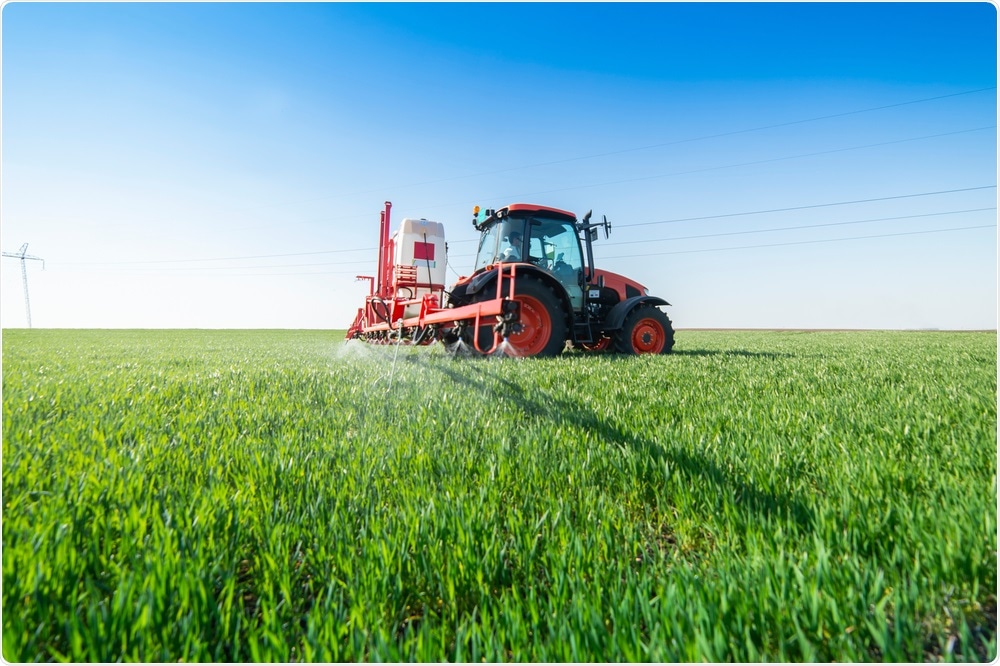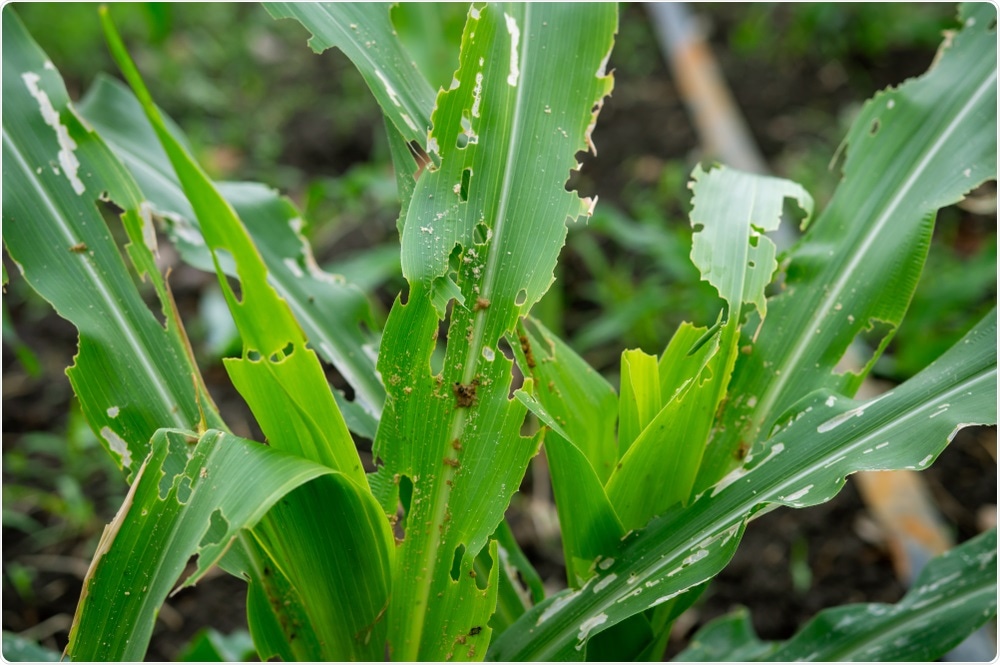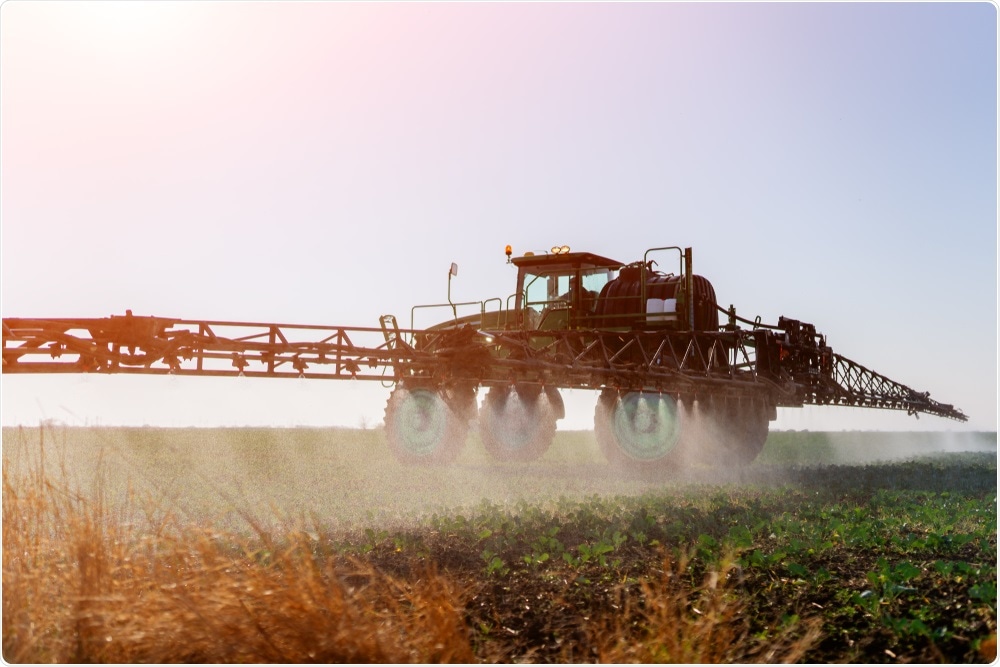What led you to begin this research?
The Plantwise program was set up to assist in the provision of agricultural advice to farmers in LMICs and gathers information from the interactions with plant doctors and farmers that take place at plant clinics all around the world.
Plant doctors are trained agronomists who advise farmers on how to manage pests and diseases they encounter. It was whilst looking at the data on the recommendations made to farmers that we became interested in how often antibiotics were being suggested as a treatment for plant health problems.

Image Credit: vlalukinv/Shutterstock.com
Why are antibiotics sometimes used in crop production?
Antibiotics are active against bacteria and can be used to protect against some bacterial problems. Their use in agriculture is primarily the same as in animals and humans, they are to either control or prevent diseases and have been used to control bacterial problems such as fire blight in apples and pear trees, but are not very effective against bacteria, once they have entered the plant.
What have your findings indicated about the scale of antibiotic use in crop production?
The results of our study indicate that antibiotics are being used far more widely and on a greater variety of crops than previously reported. The focus of our study was developing countries, where there have been few studies and little information exists about the extent of antibiotic usage.
There were no records on the amount of antibiotic use in the countries for which we gathered data. Therefore, the scale of use was a complete unknown before the study. Personally, I (Phil) am rather surprised at the extent of the use.
Why has the extent of antibiotic use in crop production been underestimated until now?
It is very difficult to find information on antibiotic usage in crop production as this information is simply not recorded, therefore, it was assumed that the amounts used were low.
Unlike many developed countries where antibiotic use is restricted (often requiring a medical prescription), much of the developing world has no restrictions on their use and they are freely available over the counter at agro-input supply shops and pharmacies.
The amounts used are comparatively low compared to animal agriculture but nevertheless significant especially as they are being used differently.

Breakdown of problems against which antibiotics were recommended by region. The larger pie chart shows the proportion of problems that were bacterial and the smaller pie chart shows a breakdown of the non-bacterial problems.
Why are people monitoring use in medical and veterinary settings but not in crop production?
A lot of this comes down to awareness and the assumption that antibiotics, particularly those important in human medicine, are not widely applied to crops. In many of the countries, we have data for there is very little monitoring of what farmers apply to their crops in general.
Our research would indicate that antibiotics are routinely used in crop production especially on crops like rice where they are applied, almost like a tonic, to protect plants from bacterial infection.
How are some people misinformed on the use of antibiotics in an attempt to combat insect pests?
We were surprised to see that antibiotics were being included as part of a suite of chemicals recommended by some of the crop advisors to treat insect problems.
The most plausible explanation is that they are putting together a cocktail of ingredients that will keep all pathogens and pests at bay. They sometimes suggest a blend of an antibiotic along with a fungicide and an insecticide and this seems to be an attempt to cover the problems the farmer is worried about as well as the ones they did not know they had and the ones they have not got yet.
It is interesting to note that in medicine it is a common misconception that antibiotics will cure a viral complaint whereas this does not seem to be the case in plants, there were very few recommendations of antibiotics against viral diseases.
We concluded that either the advisors erroneously thought that the antibiotics would kill the insects, or they were including them as a profolatic (protective) spray to prevent bacterial diseases from occurring on the crop.

Image Credit: RachenStocker/Shutterstock.com
How have your results varied around the world?
We observed some big differences in the extent of antibiotic recommendations between countries and regions. Interestingly antibiotics were not recommended in the 12 African countries studied but were widely used in Southeast Asian and Latin American countries.
There is also considerable variation in the kinds of antibiotics used around the world to some areas preferring medical ones whereas in other areas specific plant ones are used.
We have not disclosed individual country data as that would breach confidentiality agreements but there is a huge variation in the extent of antibiotics use in countries that are neighbors.
How could countries be incentivized to monitor antibiotic levels in crop production?
The recording of antibiotic usage in all sectors, humans, animals, and plants needs to be improved generally, with the developing world lagging behind the more developed countries. The impact of the widescale use of antibiotics in animal production is only now starting to be unraveled and there are still many unanswered questions about how their use might contribute to antibiotic resistance in humans.
It is hoped that studies like this will start to shine a light on the unregulated use of antibiotics in other sectors and will encourage governments and regulators to assess just how widespread the use is, and to determine whether interventions are needed.
It is my (Phil) belief that we should be actively discouraging the use of medically important antibiotics on crops and that those which are not medically important should be assessed with regard the risk they pose to the environment and whether their continued use could lead to antibiotic-resistant pathogens of people or animals (there will undoubtedly be plant pathogens that become resistant to the antibiotic).
How could this type of antibiotic use lead to antibiotic resistance in human pathogens?
Bacteria reproduce very quickly and can transfer genetic material between populations. The widescale use of antibiotics creates a selection pressure favoring those populations that are resistant to the antibiotic being applied.
The concern is that those resistance genes could be transferred to human pathogens by lateral gene flow in the wider environment or when consumed, especially as crops are often eaten raw. The jury is still very much out as to how much of a risk this poses and more concerted research is required in this area.
How could mixing with agrochemicals speed up this process?
The antibiotics used on crops are often mixed with other agrochemicals, insecticides, fungicides, etc. This use has led to concerns over interactions that might promote cross-resistance or co-selection for antibiotic resistance. This can occur if the genes for antibiotic resistance are associated with those that confer resistance to other agrochemicals.
The increased selection pressure means that the development of resistance is accelerated and in one study antibiotic resistance was found to develop up to 100,000 times faster when exposed to certain herbicides/antibiotic mixtures.

Image Credit: Marcel Poncu/Shutterstock.com
This research could be used to increase the debate around the use of antibiotics in agriculture. In your opinion, to what extent, if at all, should they be used?
Indeed, now that we have a small window on the antibiotic use we can at least talk about it. It is my personal opinion that antibiotics are a wonderful natural resource that nature has provided to the modern world and spraying them on crops or giving them to farm animals as a means of covering up poor sanitation (in both crop production and animal husbandry) is squandering their use.
There are non-medical antibiotics that have been developed specifically for plant diseases and there is a stronger case for using them provided that their use does not promote resistance in the medically important ones. The whole business of antibiotic resistance ties plant health in with animal health and human health, we should include plant health in the whole concept of “one health”.
What are the next steps for your research?
We will continue to monitor the uses of antibiotics and other agrochemicals being recommended by Plant Doctors in the countries where the Plantwise program is active. The recording of the use of agrochemicals such as herbicides, insecticides, fungicides, in lower-income countries is not well documented and Plantwise whilst continuing to educate agronomists and farmers over the potential dangers of certain agrochemicals is also gathering vital information about the extent and use of these chemicals.
We are also writing papers on the use of fungicides and insecticides, one will follow on herbicides as well as one on the use of natural botanical extracts to control pests and diseases.
About Dr. Phil Taylor
Philip Taylor was an Academic Researcher investigating induced resistance in crop plants at the University of Hull before leaving behind the academic life to run a farm in South East England.
In the years as a farmer, he grew a wide variety of crops including both GM and organic.
On return to a more academic lifestyle at CABI, he has taken on and extended the Plantwise training material. This training has been provided to extension workers in 32 countries training them in the principles of crop pest and disease identification and management.
The training is now in the form of a monthly quiz (Plantwise blog) and online in the CABI Academy.
About Dr. Rob Reeder
Rob is a plant pathologist and team leader at CABI’s centre in Egham in the UK, providing diagnostic and technical support for plant health issues. His scientific and development career spans 27 years and over 23 countries. During this time, he has worked on and managed projects in plant health and undertaken consultancies for private companies. His early career involved research on the biological control of tropical weeds with fungi.
For the past 17 years, his attentions has been focused on the diagnosis and management of tropical pests and diseases and the strengthening of plant health services in developing countries. During this period, he managed the diagnostic and advisory service (DAS) based in Egham, UK, and have been integral to the development of the Plantwise program. The DAS offers diagnostic services and management advice, free-of-charge, to developing countries and has been instrumental in the detection and monitoring of many of the recent pest and disease outbreaks in Africa, Asia, and the Americas.
The Plantwise program, led by CABI, started in 2011 is now active in 33 countries around the world. The program helps to strengthen diagnostic networks and plant health systems by training extension agents and working closely with national agricultural advisory services to establish and support sustainable networks of plant clinics. He has worked closely with extension services in many overseas countries and continues to support the Plantwise program through expert advice on the diagnosis and management of plant health problems using IPM approaches. Most recently, he has focused on quality assurance aspects within the program and the validation of the diagnosis and recommendations made by plant doctors around the world.